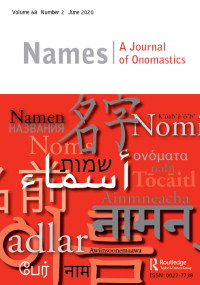Published 2020-04-02
Keywords
- nicknames,
- football,
- soccer,
- sports,
- team
- FIFA ...More
Copyright (c) 2020 American Name Society

This work is licensed under a Creative Commons Attribution 4.0 International License.
Abstract
This comparative study examines the names of handcrafted soaps, a group of natural products that has become popular among environmentally conscientious consumers in recent years. In particular, 339 names of US-based handcrafted soaps (US-HS) and 324 names of Taiwan-based shou gong fei zhou ‘lit. hand craft soap’ (TW-HS) were analyzed and compared. The findings show that plant and food names predominate in HS names and reflect the cultural and herbal preferences in both regions. In addition, colorful, allusive, and novel coinages were found to be frequent among US-HS names. By comparison, function-denoting words were mainly found among TW-HS names. This study provides insights into potential cross-cultural variations in consumer product naming.
References
- Charmasson, H. 1988. The Name is the Game—How to Name a Company or Product. Homewood, IL: Erwin Professional. Accessed 12 March 2018. https://www.jadeinstitute.com/jade/oriental-herb-gallery.php?order=chinese_name
- Chen, L. 2019. “Communicating Health and Wellness: The Meaning behind Names of Handmade Soaps.” English Today 35, no.1: 14–19.
- Cross, M. 2015. The Handmade Soap Book, Updated 2nd Edition. Grantham, UK: IMM Lifestyle.
- Danesi, M. 2011. “What’s in a Brand Name? A Note on the Onomastics of Brand Naming.” Names 59, no. 3: 175–85.
- Dong, L., and M. Helms. 2001. “Brand Name Translation Model: A Case Analysis of US Brands in China.” Journal of Brand Management 9, no. 2: 99–115.
- Fox, K. 2005. The Smell Report. Oxford: Social Issues Research Center. Accessed 8 April 2018. http://www.sirc.org/publik/smell.pdf.
- Haig, M. 2011. Brand Failures: The Truth about the 100 Biggest Branding Mistakes of All Time. London: Kogan Page.
- Hall, M. 2008. “The Marketing of Organic Products: An Instrumental/Symbolic Perspective.” Journal of Food Products Marketing 14, no. 3: 1–11.
- Haugen, J. 2009. “Borrowed Borrowings: Nahuatl Loan Words in English.” E-Journal in Lexicology. 3: 64–106.http://journals.openedition.org/lexis/638
- Hsu, E., and S. Harris. 2010. Plants, Health and Healing: On the Interface of Ethnobotany and Medical Anthropology. New York: Berghahn Books.
- Kakudidi, E. 2004. “Cultural and Social Uses of Plants from and around Kibale National Park, Western Uganda.” African Journal of Ecology 42, no. s1: 114–8.
- Miller, L. 2006. Beauty Up: Exploring Contemporary Japanese Body Aesthetics. Berkeley: University of California Press.
- Nuessel, F. 2018. “A Note on Selected Craft Beer Brand Names.” Names 66, no. 2: 106–15.
- Ottman, J. (ed.). 2011. “The New Rules of Green Marketing: Strategies, Tools, and Inspiration for Sustainable Branding.” San Francisco: Berrett-Koehler Publishers.
- Parsonage Soap Company. 2015. “Essential Oil Soaps–Lavender Lime.” Accessed 20 January 2018. https://squareup.com/market/parsonagesoaps/item/lavender-lime
- Pérez Hernández, L. 2013. “A Pragmatic-Cognitive Approach to Brand Names: A Case Study of Rioja Wine Brands.” Names 61, no. 1: 33–46.
- Rondilla, J., and P. Spickard. 2007. Is Lighter Better?: Skin-Tone Discrimination among Asian Americans. Lanham, MD: Rowman & Littlefield Publishing.
- Sarkar, A. N. 2012. “Green Branding and Eco-Innovations for Evolving a Sustainable Green Marketing Strategy.” Asia-Pacific Journal of Management Research and Innovation 8, no. 1: 39–58.

